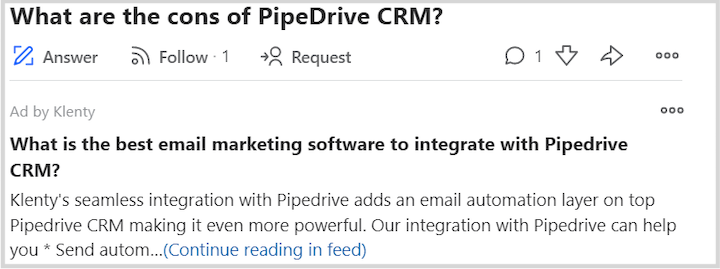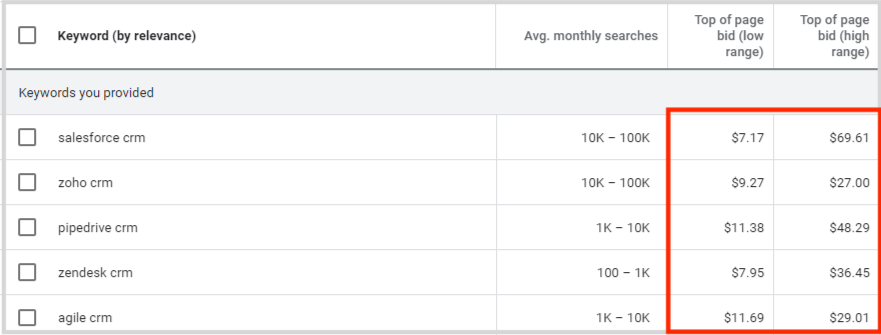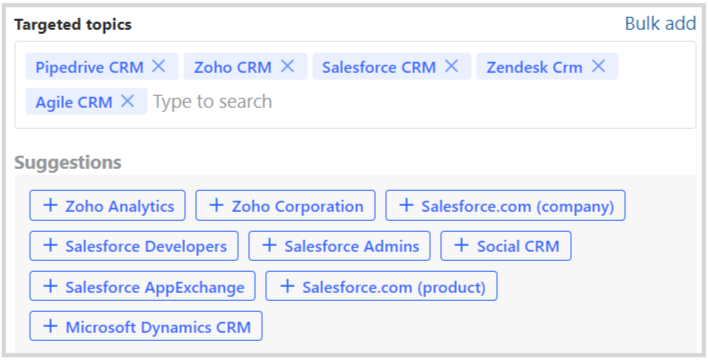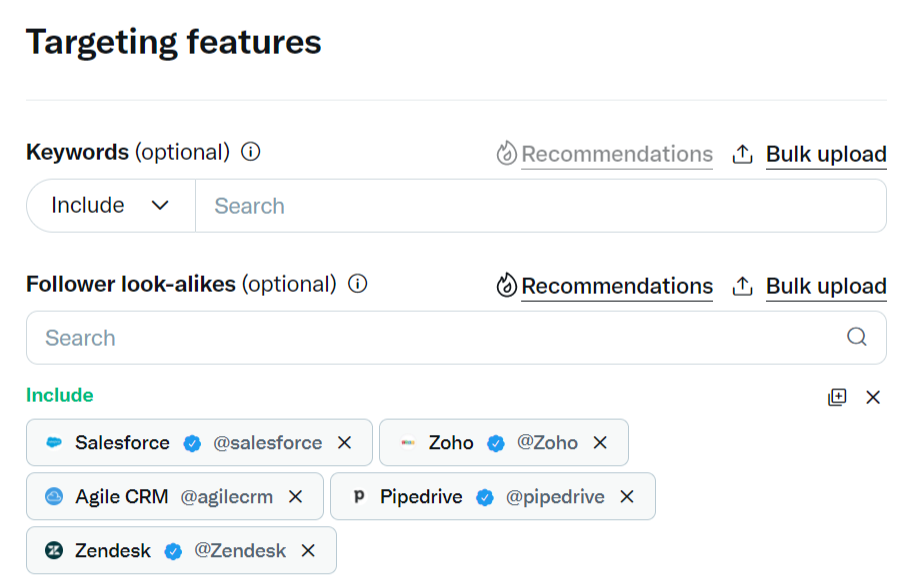Targeting competitors’ keywords with Google As is effective but can get expensive. Which is why I recently shared a few ways you can target your competitors on Google Ads without using Search. These suggestions stayed within Google Ads, so in this post, I want to talk about other less expensive ways you can reach your competitors’ audience without using Google. We’ll be focusing on paid social instead. These include:
- Quora ads by topic or interest
- LinkedIn Member Groups
- Twitter follower Look-alikes
3 less expensive ways to target competitors on paid social
For this post, I’m going to pretend I have a client that is a CRM brand. If I am looking to target competitor keywords on Google Search, let’s take a look at the prices I may have to pay for these keywords in the United States.
$7.17 all the way up to $69.61
Now let’s see if we can find less expensive, yet still effective, ways to target similar users. I acknowledge these aren’t going to be apples to apples comparisons in audience targets. I also acknowledge the user intent for search ads is different than with social media ads, but we can still get in front of a relevant audience that has shown interest in your competitors.
1. Quora ads topics or interests
Quora is a question and answer site that offers a variety of ways to target its users. The most specific form of targeting with Quora ads (but also the lowest volume) would be to target individual questions. If you only want your ad to show on a very specific question, you can do that.

If people are researching which CRM is the best, or in the example above what are the faults of certain CRMs, you can place your ad on that question to showcase why your product is the better option. But as I stated above, question targeting is not going to have a lot of volume, which is why I recommend targeting Topics or Interests first.
Quora question targeting is not going to have a lot of volume, which is why I recommend targeting Topics or Interests first.
All questions in Quora are categorized under Topics. If you target a Topic, your ad could appear on any question within that Topic, while a user is currently on the page. Interests use the same targeting options as Topics, the difference being that it will target people who have interacted with the questions or answers of a Topic at some point in the recent past.
In this case, I can find my competitors as Topics on Quora. What you can’t see in the image is that these five Topics have 200,000 to 300,000 weekly impressions. Pretty good volume. Now what is the recommended bid for these Topics?
$0.24 – $1.28. Even at the high end of the bid range, the amount is far less than what we’d have to pay for those above keywords on Google. I am pretty sure you can find a few areas in your accounts where ad spend is being wasted and bring it over to Quora to test.
>>Use our Free Google Ads Grader or Free Facebook Ads Grader to find wasted spend.
2. LinkedIn Member Groups
LinkedIn ads have a reputation of being expensive, but that doesn’t always have to be the case. There are several targeting options that are less expensive than the popular Job Title or Company match targets. I love to use Member Groups to find users who are interested in my services, or in this case, my competitors’ services.
In our example for this post, some member groups I could target are those for Salesforce, Zoho, Pipedrive, Agile, and Zendesk:

These were just some of the Member Groups I could target. But targeting users who like to participate in active discussions about a product could be a pretty relevant audience. I will admit if users are dedicated to a particular product, they might be harder to convince to switch, so it’s worthwhile to visit each group and see what people are discussing. If you’re noticing complaints or pain points, or see that you can offer features better than what everyone is talking about, you may want to target these groups.
Now what is the cost for the Member Groups I picked above?
$12.65 – $27.87 with a recommendation of $17.24. If I choose manual bidding, the lowest bid I can use is $4.45— much lower than Google Search. Even if I use the bid recommendations from similar advertisers, it’s lower than Google Search. Another avenue I may want to test if I’m not getting the performance I want from competitor Search campaigns.
Individuals in groups dedicated to product users will be hard to convert, so visit the group first to see if there are complaints or pain points you can capitalize on.
3. Twitter follower look-alikes
I will be the first to admit this is not as direct of a targeting option as my other examples, but it can work. In Twitter ads, you cannot target the followers of other accounts on Twitter, but what you can do is advertise to people who have similar behaviors as an account’s followers. How does Twitter determine a person fits within the look-alike?
Here’s what Twitter states: “We determine users similar to those who follow accounts based on a variety of signals, including what they Retweet, click on, Tweet, and more.”
When creating your ad group, head down to Targeting Features. You should easily see the Follower look-alikes section. Start typing in each of your competitor’s Twitter handles and select each one.
Twitter is going to recommend targeting at least thirty accounts for follower look-alikes. Take that with a grain of salt. I recommend only choosing specific accounts that fit your target audience no matter how many that is. Now let’s look at the costs.
$0.70 – $3.80. This ad group didn’t have any additional layers added to the targeting. We can see the bid suggestions are, once again, much lower than Google. While the targeting option is definitely not as relevant as keyword targets, you still can use your competitors’ brand recognition to try and reach a relevant audience.
Twitter recommends targeting at least thirty accounts for follower look-alikes, but I recommend only choosing specific accounts that fit your target audience no matter how many that is.
We have more options than targeting competitor keywords
Yes, users typing in keywords on a search engine like Google or Bing will have a deeper intent, but people visit many more websites than search engines. Paid social platforms can offer effective and much more affordable options when trying to use competitors in your targeting. As I mentioned earlier in the post, I am pretty sure every account can find areas to pause or clean up. Use this new ad spend to test out different strategies in other channels. The results may surprise you.
The post Targeting Competitor Keywords: My Favorite 3 Lower-Cost Alternatives appeared first on WordStream.
If you liked Targeting Competitor Keywords: My Favorite 3 Lower-Cost Alternatives by Joe Martinez Then you'll love Miami SEO Expert







